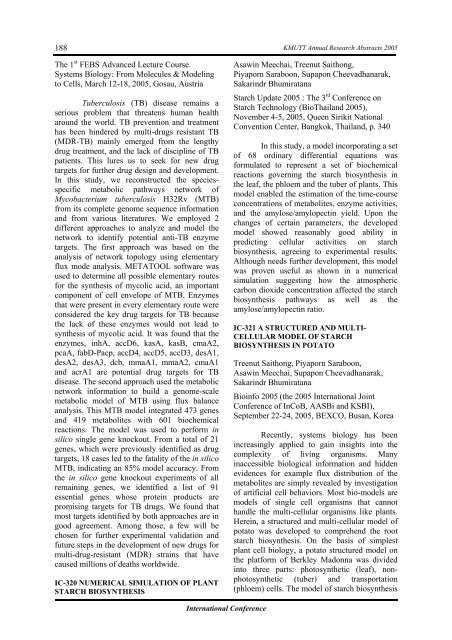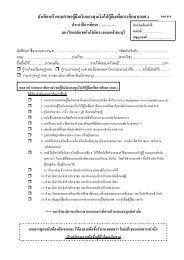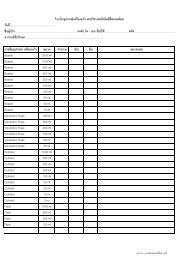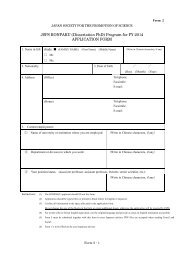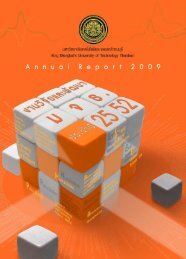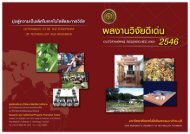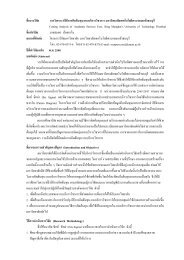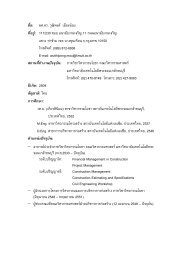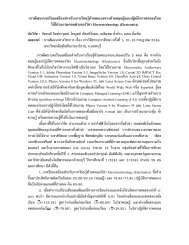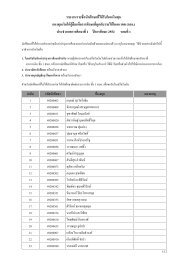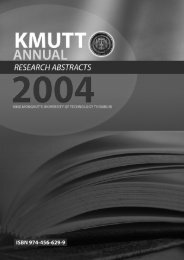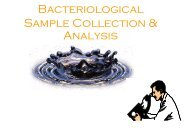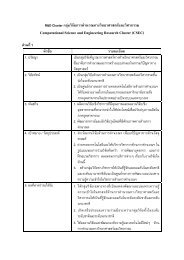You also want an ePaper? Increase the reach of your titles
YUMPU automatically turns print PDFs into web optimized ePapers that Google loves.
188<br />
The 1 st FEBS Advanced Lecture Course.<br />
Systems Biology: From Molecules & Modeling<br />
to Cells, March 12-18, 2005, Gosau, Austria<br />
Tuberculosis (TB) disease remains a<br />
serious problem that threatens human health<br />
around the world. TB prevention and treatment<br />
has been hindered by multi-drugs resistant TB<br />
(MDR-TB) mainly emerged from the lengthy<br />
drug treatment, and the lack of discipline of TB<br />
patients. This lures us to seek for new drug<br />
targets for further drug design and development.<br />
In this study, we reconstructed the speciesspecific<br />
metabolic pathways network of<br />
Mycobacterium tuberculosis H32Rv (MTB)<br />
from its complete genome sequence information<br />
and from various literatures. We employed 2<br />
different approaches to analyze and model the<br />
network to identify potential anti-TB enzyme<br />
targets. The first approach was based on the<br />
analysis of network topology using elementary<br />
flux mode analysis. METATOOL software was<br />
used to determine all possible elementary routes<br />
for the synthesis of mycolic acid, an important<br />
component of cell envelope of MTB. Enzymes<br />
that were present in every elementary route were<br />
considered the key drug targets for TB because<br />
the lack of these enzymes would not lead to<br />
synthesis of mycolic acid. It was found that the<br />
enzymes, inhA, accD6, kasA, kasB, cmaA2,<br />
pcaA, fabD-Pacp, accD4, accD5, accD3, desA1,<br />
desA2, desA3, dcb, mmaA1, mmaA2, cmaA1<br />
and acrA1 are potential drug targets for TB<br />
disease. The second approach used the metabolic<br />
network information to build a genome-scale<br />
metabolic model of MTB using flux balance<br />
analysis. This MTB model integrated 473 genes<br />
and 419 metabolites with 601 biochemical<br />
reactions. The model was used to perform in<br />
silico single gene knockout. From a total of 21<br />
genes, which were previously identified as drug<br />
targets, 18 cases led to the fatality of the in silico<br />
MTB, indicating an 85% model accuracy. From<br />
the in silico gene knockout experiments of all<br />
remaining genes, we identified a list of 91<br />
essential genes whose protein products are<br />
promising targets for TB drugs. We found that<br />
most targets identified by both approaches are in<br />
good agreement. Among those, a few will be<br />
chosen for further experimental validation and<br />
future steps in the development of new drugs for<br />
multi-drug-resistant (MDR) strains that have<br />
caused millions of deaths worldwide.<br />
IC-320 NUMERICAL SIMULATION OF PLANT<br />
STARCH BIOSYNTHESIS<br />
KMUTT Annual Research Abstracts 2005<br />
Asawin Meechai, Treenut Saithong,<br />
Piyaporn Saraboon, Supapon Cheevadhanarak,<br />
Sakarindr Bhumiratana<br />
Starch Update 2005 : The 3 rd Conference on<br />
Starch Technology (BioThailand 2005),<br />
November 4-5, 2005, Queen Sirikit National<br />
Convention Center, Bangkok, Thailand, p. 340<br />
In this study, a model incorporating a set<br />
of 68 ordinary differential equations was<br />
formulated to represent a set of biochemical<br />
reactions governing the starch biosynthesis in<br />
the leaf, the phloem and the tuber of plants. This<br />
model enabled the estimation of the time-course<br />
concentrations of metabolites, enzyme activities,<br />
and the amylose/amylopectin yield. Upon the<br />
changes of certain parameters, the developed<br />
model showed reasonably good ability in<br />
predicting cellular activities on starch<br />
biosynthesis, agreeing to experimental results.<br />
Although needs further development, this model<br />
was proven useful as shown in a numerical<br />
simulation suggesting how the atmospheric<br />
carbon dioxide concentration affected the starch<br />
biosynthesis pathways as well as the<br />
amylose/amylopectin ratio.<br />
IC-321 A STRUCTURED AND MULTI-<br />
CELLULAR MODEL OF STARCH<br />
BIOSYNTHESIS IN POTATO<br />
Treenut Saithong, Piyaporn Saraboon,<br />
Asawin Meechai, Supapon Cheevadhanarak,<br />
Sakarindr Bhumiratana<br />
Bioinfo 2005 (the 2005 International Joint<br />
Conference of InCoB, AASBi and KSBI),<br />
September 22-24, 2005, BEXCO, Busan, Korea<br />
Recently, systems biology has been<br />
increasingly applied to gain insights into the<br />
complexity of living organisms. Many<br />
inaccessible biological information and hidden<br />
evidences for example flux distribution of the<br />
metabolites are simply revealed by investigation<br />
of artificial cell behaviors. Most bio-models are<br />
models of single cell organisms that cannot<br />
handle the multi-cellular organisms like plants.<br />
Herein, a structured and multi-cellular model of<br />
potato was developed to comprehend the root<br />
starch biosynthesis. On the basis of simplest<br />
plant cell biology, a potato structured model on<br />
the platform of Berkley Madonna was divided<br />
into three parts: photosynthetic (leaf), nonphotosynthetic<br />
(tuber) and transportation<br />
(phloem) cells. The model of starch biosynthesis<br />
International Conference


